This site uses affiliate links, meaning that if you make a purchase through our links, we may earn an affiliate commission.
Yellowstone National Park, with its breathtaking landscapes and diverse wildlife, is a photographer’s paradise!
From geothermal wonders to expansive vistas, this iconic park offers an abundance of opportunities to capture stunning images.
In this post, we will guide you through the top 12 photography locations in Yellowstone while providing valuable tips to help you make the most of your visit.
Whether you are a seasoned pro or a novice shutterbug, get ready to unleash your creativity in one of America’s most iconic natural wonders!
- 1. Yellowstone National Park At-A-Glance
- 2. Map With Best Photography Locations in Yellowstone
- 3. 12 Best Photography Locations in Yellowstone (Plus Useful Photo Tips)
-
- 3.1. Grand Prismatic Spring
- 3.2. Old Faithful Geyser at Sunset
- 3.3. Upper Geyser Basin: Morning Glory Pool
- 3.4. Lamar Valley Wildlife
- 3.5. The Grand Canyon of Yellowstone
- 3.6. Mammoth Hot Springs Terraces at Sunset
- 3.7. Hayden Valley at Sunrise
- 3.8. Yellowstone Lake
- 3.9. Biscuit Basin
- 3.10. Firehole Falls
- 3.11. Fairy Falls
- 3.12. Fountain Paint Pots
- 4. Intrepid Scout's Tips for Best Photography Locations in Yellowstone
Yellowstone National Park At-A-Glance
Before diving in, here are a few Yellowstone National Park highlights to help you plan your trip:
- When Is the Best Time to Visit Yellowstone National Park
The best time to visit Yellowstone National Park is during the shoulder seasons of spring (April and May) and fall (September and October). The weather is relatively mild and the crowds are thinner. Wildlife is also active during these times, making it an ideal opportunity for viewing animals. However, if you’re looking to experience the park’s full range of activities and amenities, the summer months offer the most options despite larger crowds. On the other hand, winter provides a unique chance for a serene and snowy adventure.
- Which Entrance Is the Best Gateway to the Park
Before you embark on your journey to Yellowstone, there is a pivotal decision to be made: which Yellowstone entrance is the best gateway for your adventure?
With a grand total of 5 entrances to Yellowstone to choose from, each offering its unique set of advantages and considerations, the task of selection might seem a tad overwhelming.
So here, we present your comprehensive guide to Yellowstone’s 5 entrances complete with insights on the optimal routes to reach each entrance, the nearest attractions to explore, and the best lodging options: 5 Entrances to Yellowstone (Which One Is the Best Gateway to the Park)
- Where to Stay When Visiting Yellowstone National Park
Accommodation options include lodges and cabins inside the park like the Old Faithful Inn, camping at various campgrounds, and lodging in gateway towns such as West Yellowstone, Gardiner, Cooke, and Cody.
Reservations are essential for in-park lodges and popular campgrounds due to high demand. Find out Where to Stay When Visiting Yellowstone (20 Best Lodging Options Inside and Near Yellowstone).
- How to Get Around in Yellowstone National Park
Unlike many other national parks, Yellowstone does not offer a public shuttle system. There is an automated shuttle pilot program in Canyon Village that launched in 2021, and there could be more to come in the future. But for now, having your vehicle is the only way to get around the park.
- How Much Does It Cost to Vist Yellowstone National Park
To visit Yellowstone National Park, you need to purchase a recreational day-use pass, which costs $35 per vehicle and is good for 7 consecutive days. You can purchase the pass right at the entrance to the park. If you are visiting several national parks then make sure to get America the Beautiful National Park Pass. This $80 pass is valid for 12 months and gets you into all 400+ national park sites!
- Check Yellowstone National Park Website for Trail Closures and Road Construction
You must check Yellowstone National Park’s Website for any trail or road closures before going to the park. You can check for updates HERE.
Map With Best Photography Locations in Yellowstone
12 Best Photography Locations in Yellowstone (Plus Useful Photo Tips)
Grand Prismatic Spring
The Grand Prismatic Spring is one of Yellowstone’s most iconic geothermal features, known for its vibrant colors and mesmerizing beauty.
This enormous hot spring spans over 370 feet in diameter, making it the largest in the United States.
Its striking blue center gradually transitions to brilliant shades of orange, red, and yellow, surrounded by a turquoise ring—creating a surreal visual spectacle.
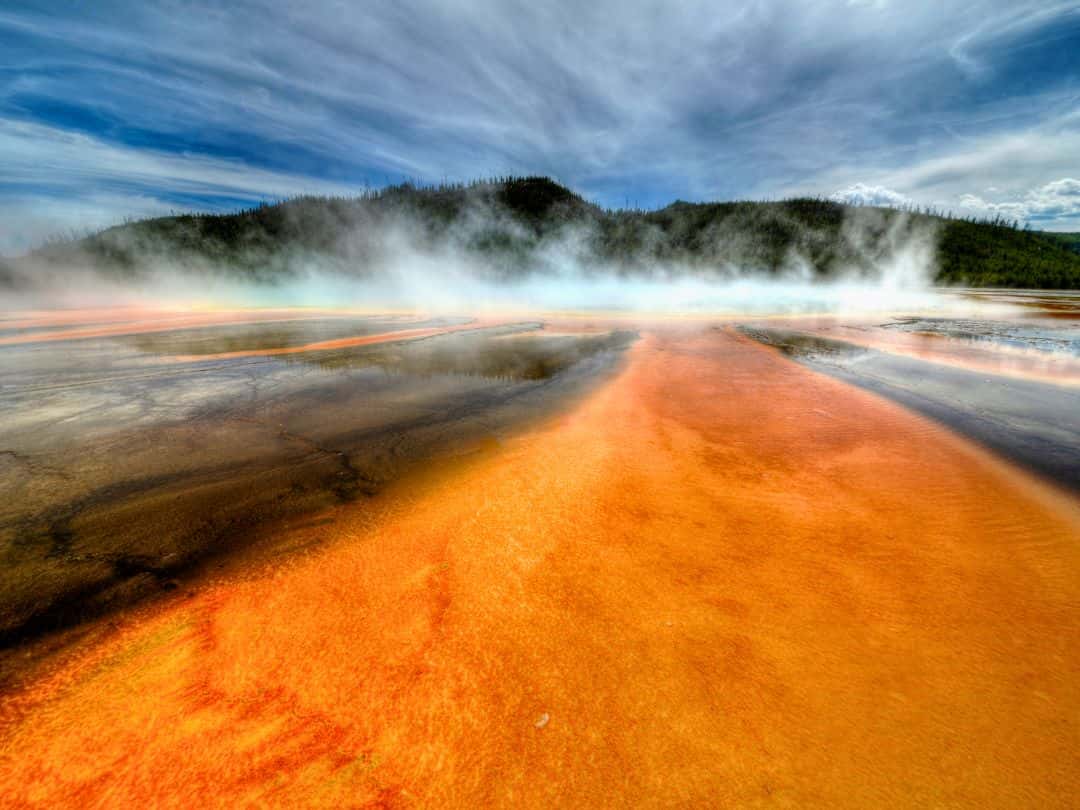
Grand Prismatic Spring / Best Photography Locations in Yellowstone
The Grand Prismatic Spring Photo Tips:
- Timing is Crucial: When photographing the Grand Prismatic Spring, timing is crucial. I recommend visiting early in the morning or late in the afternoon to capture the spring’s colors at their most vibrant. During midday, the steam can obscure the view and wash out colors.
- Elevated Viewpoint: For a unique perspective, consider hiking up to the Grand Prismatic Spring Overlook. From there, you will get an aerial view that beautifully showcases the entire spring’s intricate colors and patterns.
- Use a Polarizer: Using a polarizing filter can be a game-changer. It helps darken the skies, manage reflections, or suppress glare from the surface of the spring.
- Experiment with Composition: When composing your shots, do not forget to include the surrounding boardwalk, people, or other elements to add context and scale to your photos.
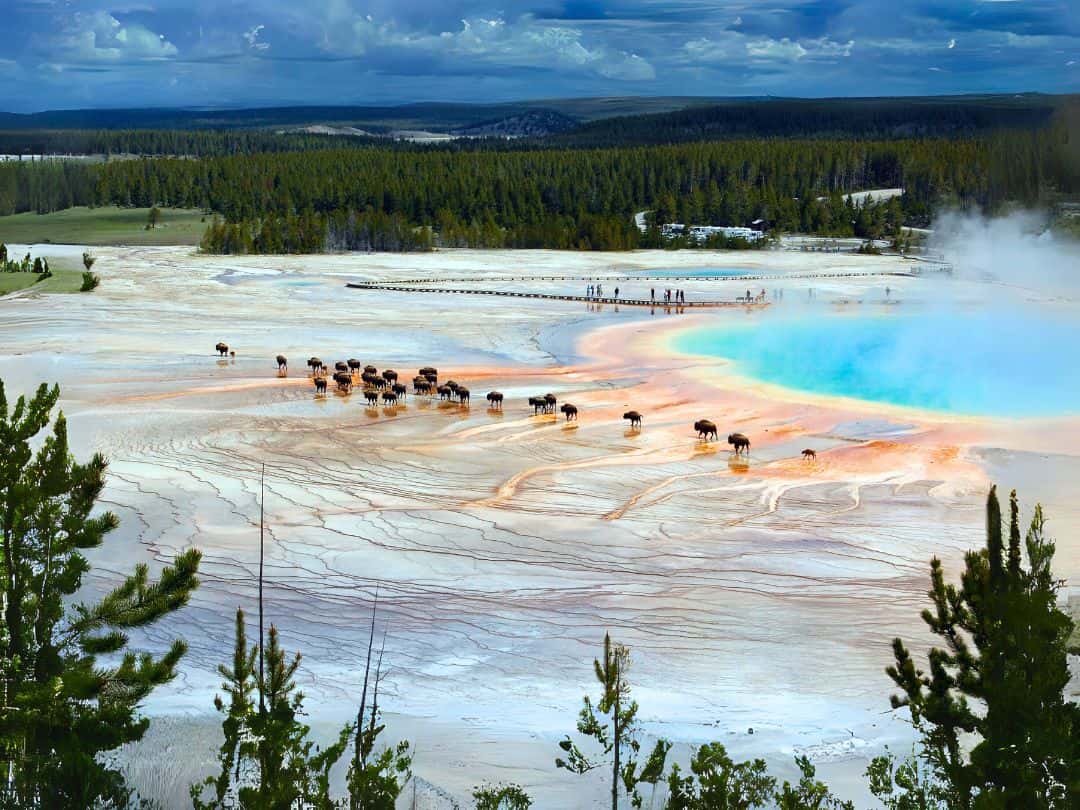
View of Grand Prismatic Spring from the Observation Point / Best Photography Locations in Yellowstone
PRO TIP: The weather can change very rapidly at Yellowstone, so be patient and wait a bit until the wind clears the steam, revealing the spring’s full glory. Be prepared to spend some time at this location for the perfect shot.
Old Faithful Geyser at Sunset
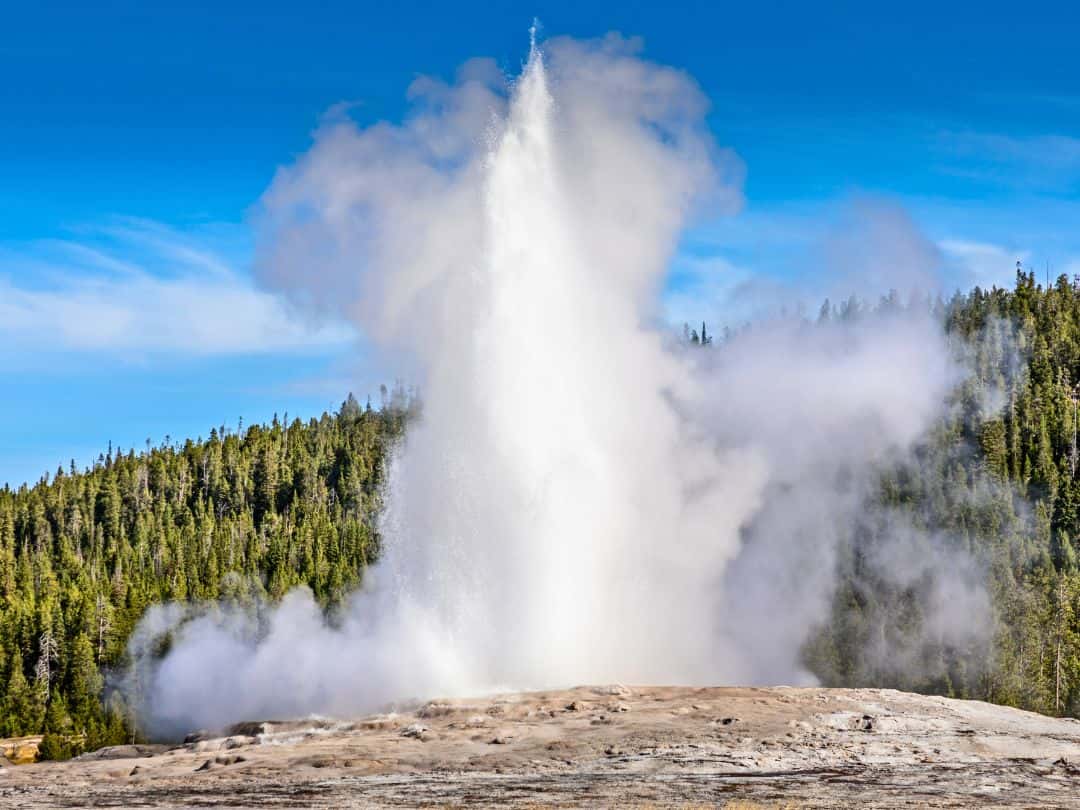
Old Faithful Geyser / Best Photography Locations in Yellowstone
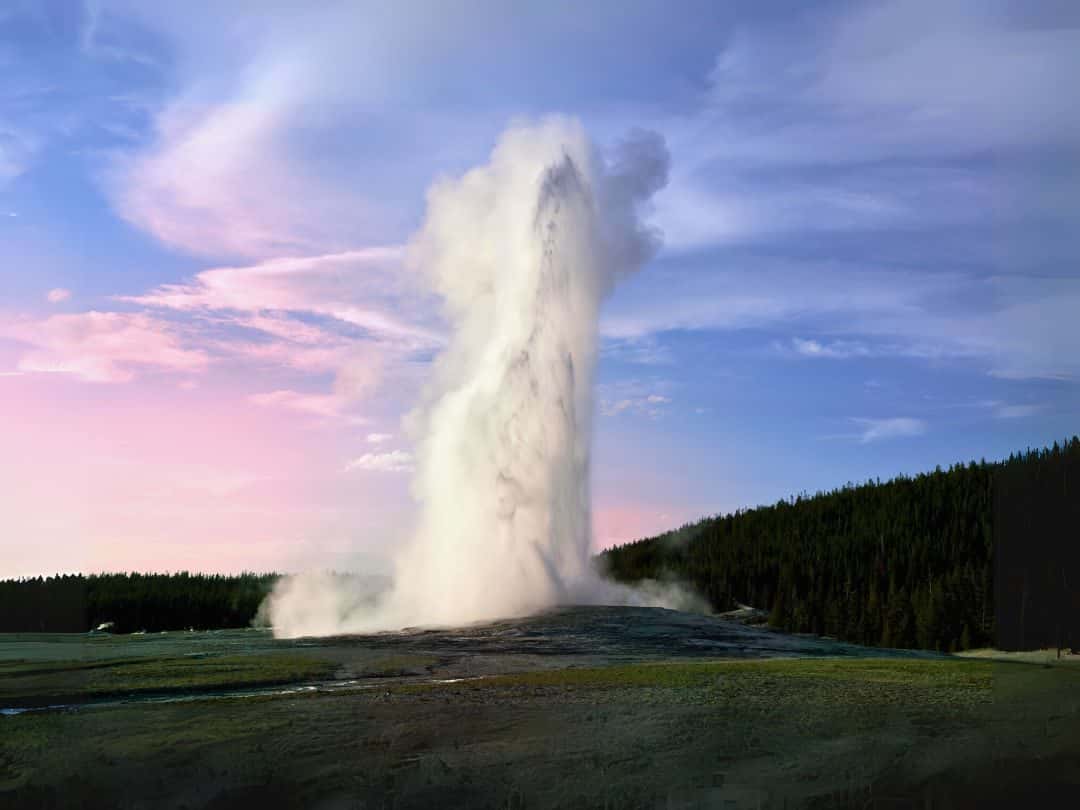
Old Faithful Geyser at Sunset / Best Photography Locations in Yellowstone
Upper Geyser Basin: Morning Glory Pool
The Upper Geyser Basin is home to not only the famous Old Faithful but also a plethora of other geysers, hot springs, and thermal features.
One of the features you cannot miss is the Morning Glory Pool, renowned for its stunning colors.
Pro Tips for Photographing the Morning Glory Pool:
- Arrive Early: To avoid crowds and capture the pristine colors of the Morning Glory Pool, visit during the early morning hours. The warm, soft light of sunrise can enhance its beauty.
- Embrace Steam and Mist: The rising steam and mist create an ethereal atmosphere. Use them to your advantage to add drama and mystery to your shots.
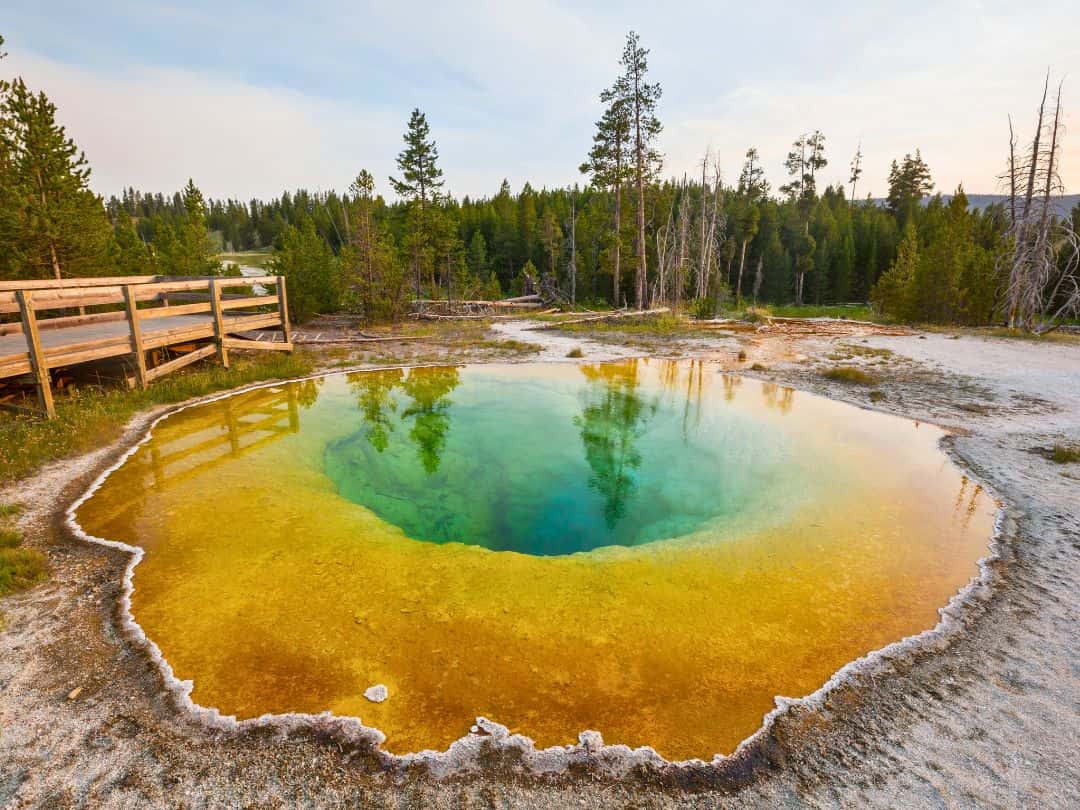
Morning Glory Pool in Upper Geyser / Best Photography Locations in Yellowstone
- Use a Wide-Angle Lens: A wide-angle lens (16-35mm) is ideal for capturing the entire pool and its surroundings, including the colorful microbial mat.
- Bracket Your Shots: Due to the extreme contrast between the pool’s vibrant colors and the surrounding environment, bracket your shots to capture details in both highlights and shadows.
- Use a Polarizer: A polarizing filter can reduce glare on the water’s surface and enhance the colors and clarity of the pool.
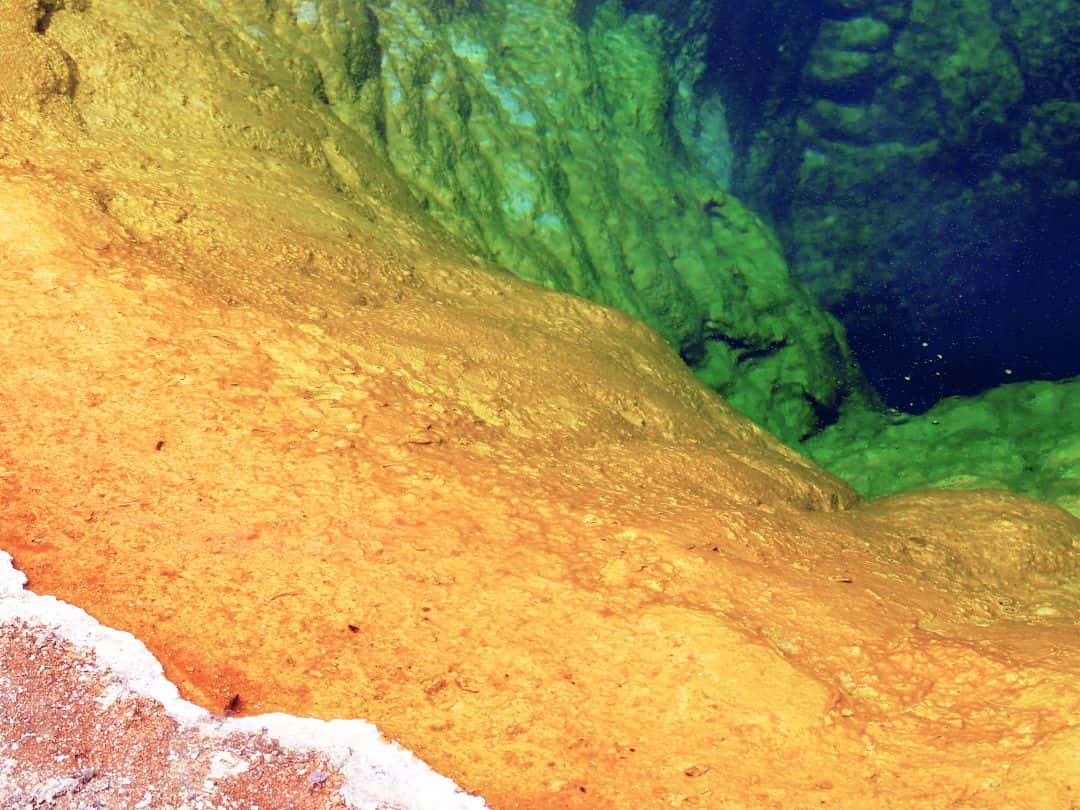
Morning Glory Pool in Upper Geyser / Best Photography Locations in Yellowstone
PRO TIPS: Schedule your visit to coincide with an eruption of Old Faithful. While Old Faithful is the star attraction, do not forget to explore and photograph the other geysers and hot springs in the area. They offer unique shapes and colors.
Lamar Valley Wildlife
Lamar Valley, often referred to as the “Serengeti of North America,” is a wildlife photographer’s dream come true. This vast, open landscape has a special place in my heart because it is where I have had some of my most memorable wildlife photography experiences.
In Lamar Valley, you will find Yellowstone’s magnificent wildlife, including bison, elk, wolves, and grizzly bears. The sweeping vistas and ever-changing light conditions make it a versatile location for capturing the park’s fauna.
Here are some tips I’ve learned through my adventures:
- Golden Hour Magic: Wildlife comes alive during the golden hours of sunrise and sunset. It’s when the soft, warm lighting truly enhances the beauty of these magnificent animals. So, plan your visit accordingly to make the most of this magical light.
- Long Lenses are Essential: To capture those elusive and distant wildlife moments without disturbing them, investing in a telephoto lens (300mm or more) is crucial for those close-up shots.
And don’t forget a good pair of binoculars to spot animals from afar.
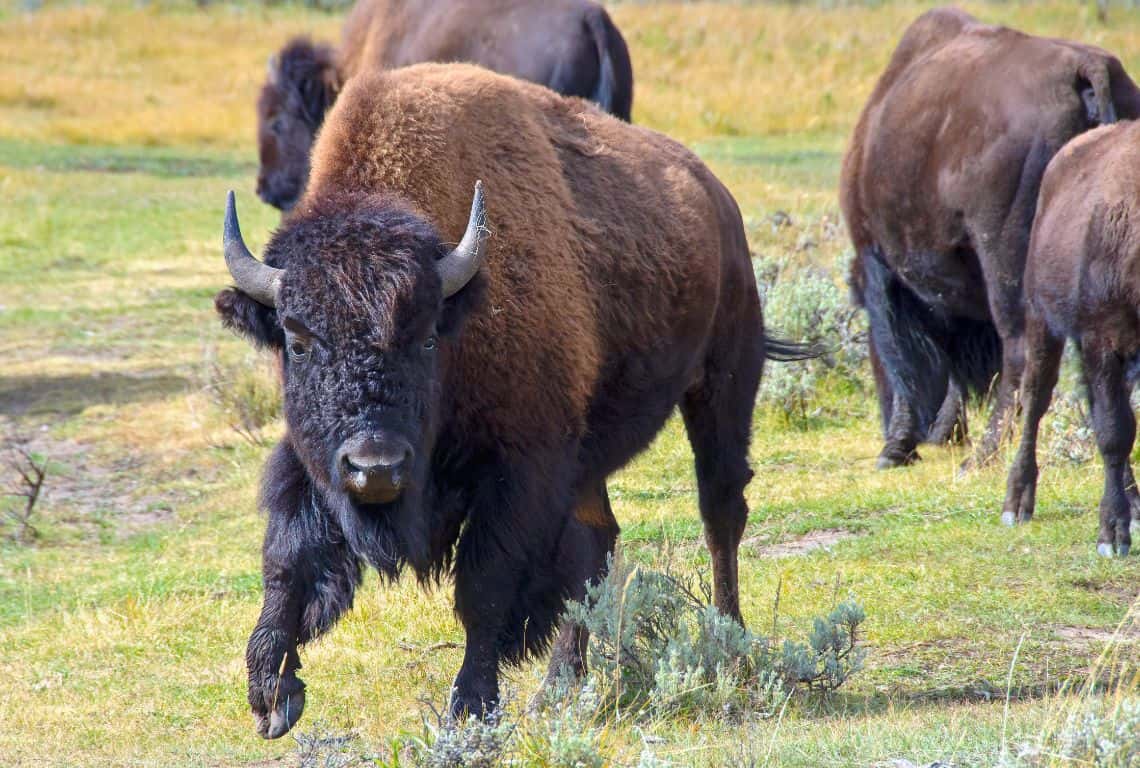
Bison in Lamar Valley / Best Photography Locations in Yellowstone
- Patience and Observation: Spend time quietly observing animal behavior before taking shots. This allows you to anticipate their actions and capture those moments that tell a compelling story.
- Include the Landscape: Incorporate the breathtaking Lamar Valley landscape into your wildlife shots. It adds context and grandeur to your photographs.
The contrast between wildlife and the vastness of nature can result in truly powerful images.
- Use a Tripod with a Gimbal Head: To maintain stability and capture those moving wildlife subjects, a sturdy tripod with a gimbal head is a valuable tool.
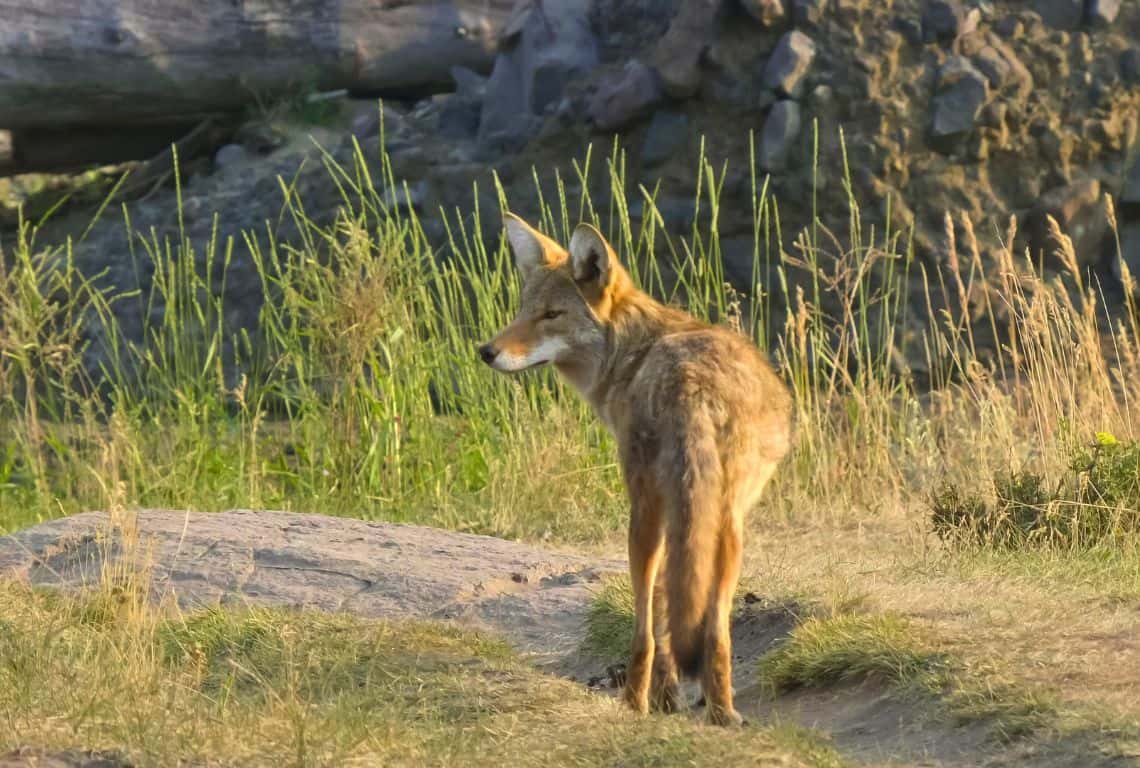
Coyote in Lamar Valley / Best Photography Locations in Yellowstone
- Silhouette Shots: There is something magical about capturing silhouettes of animals against the colorful sky during sunrise or sunset. It adds drama and emotion to your images.
- Safety and Respect: Above all, remember that safety and respect for wildlife are paramount. Always maintain a safe distance and never disturb animals for the sake of a photograph. It is our responsibility to protect both ourselves and the animals.
- Environmental Portraits: While zooming in on the animals can provide stunning close-ups, do not forget to capture environmental portraits. Including some of the landscape in your shots tells a richer story about these animals in their natural habitat.
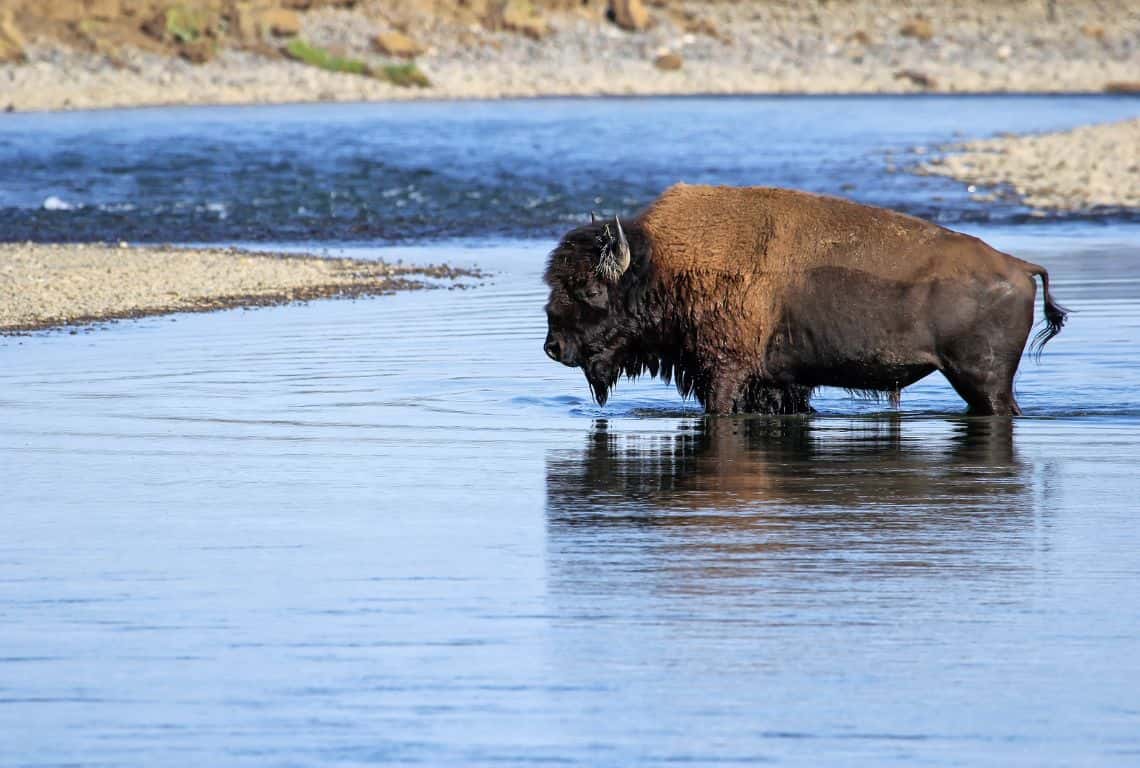
Bison in Lamar Valley / Best Photography Locations in Yellowstone
Lamar Valley has a way of getting under your skin, and it is where I have witnessed some of the most incredible moments in the wild.
So, when you venture there with your camera, embrace the magic of this special place, and let your photographs tell the stories of Yellowstone’s remarkable wildlife.
PRO TIP: If you want to learn more about the Greater Yellowstone Ecosystem, which has one of the highest levels of wildlife diversity in North America, then I am recommending a full-day private safari endeavor that will highlight the hundreds of species of animals and plants that call this place home. It is a private tour led by an experienced naturalist guide.
The Grand Canyon of Yellowstone
The Grand Canyon of Yellowstone is a place that holds a special spot in my heart. Every time I stand on its rim and gaze down at the sheer beauty of nature’s artistry, I am filled with awe and gratitude.
It is a place where I have captured some of my most cherished photographs, and I am excited to share my personal tips for exploring and photographing this breathtaking wonder.
Within the Grand Canyon of Yellowstone, there are 4 standout locations that I consider the crown jewels of this remarkable wonder:
1. Artist Point: A location that has left me breathless with every visit. From here, you will witness a panoramic view of the Grand Canyon, with the Lower Falls as its star. It’s a spot that has a way of stealing your words.
2. Inspiration Point: A short drive from Artist Point, Inspiration Point offers another jaw-dropping perspective of the canyon.
3. The Brink of Lower Falls: Standing on the brink of Lower Falls is a heart-pounding encounter with nature’s power. Here, the Yellowstone River dramatically plunges into the canyon, a moment that stays with you forever.
4. The Brink of Upper Falls: Here, the Yellowstone River takes another thrilling plunge. The viewpoint at the brink of Upper Falls offers yet another dimension of the canyon’s beauty.
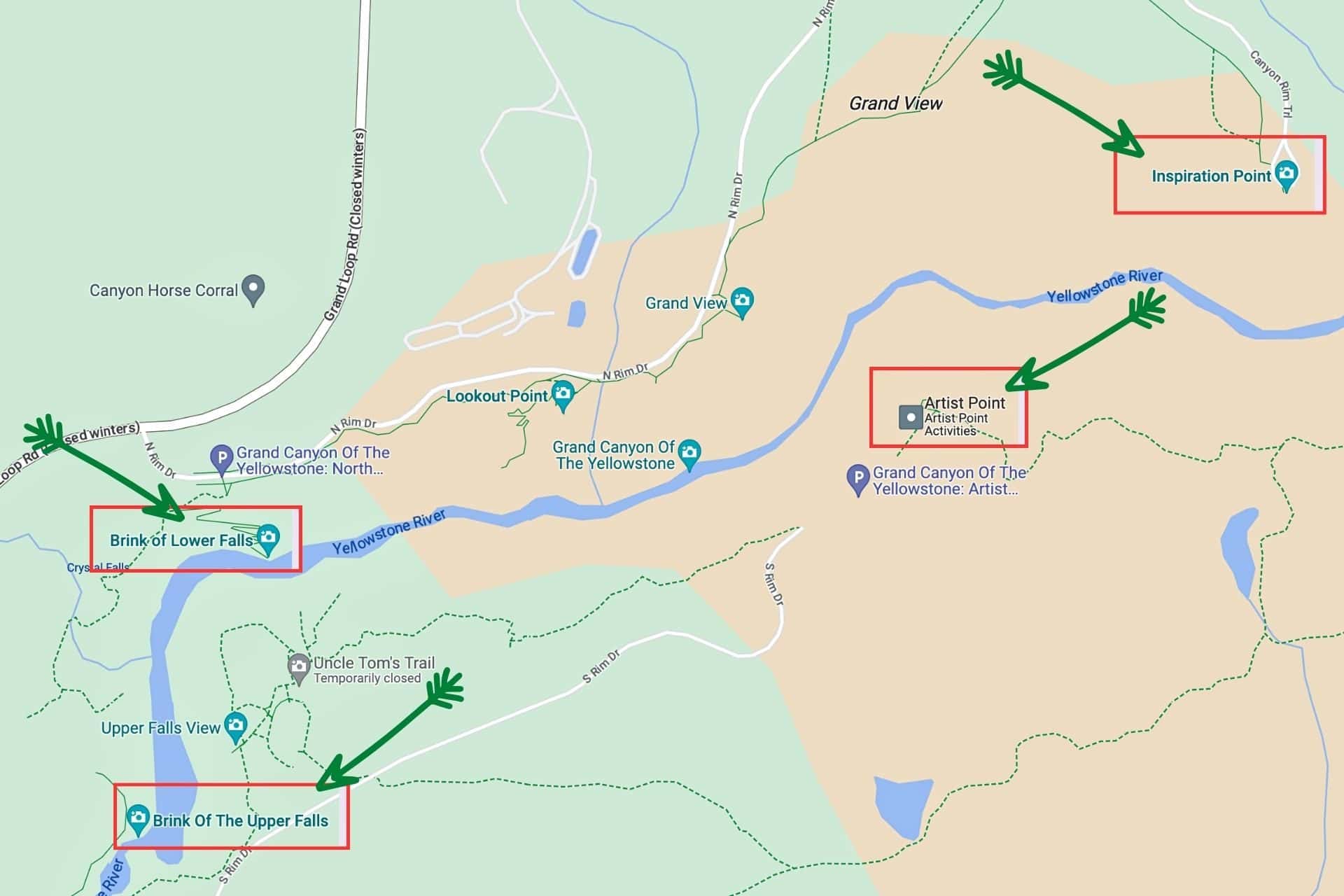
Map of the Grand Canyon of Yellowstone with the Best Photography Locations
Tips for Photographing the Grand Canyon of Yellowstone:
- Golden Hours: If you want to capture the canyon’s true magic, visit during the golden hours of sunrise or sunset. The warm, directional light enhances the canyon’s colors and textures, turning it into a photographer’s dream.
- Wide-Angle Lens: My trusty wide-angle lens (16-35mm) has always been my go-to at Artist Point. It allows you to capture the vastness of the canyon and the beauty of the falls in a single frame.
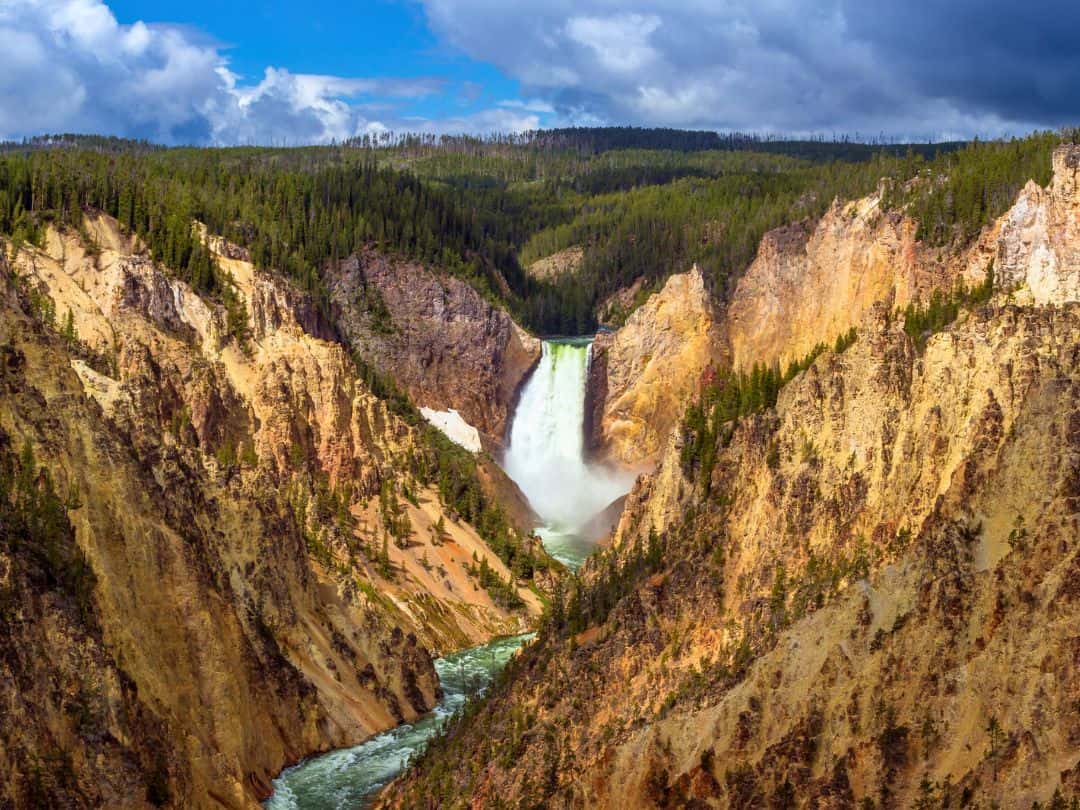
View of the Grand Canyon of Yellowstone from the Artist Point
- Experiment with ND Filters: For those dreamy, long-exposure shots of the waterfall, neutral density (ND) filters are your best friend. They enable those mesmerizing silky water effects. Just don’t forget your sturdy tripod for this technique.
- Include the Surroundings: Do not forget to incorporate the surrounding landscape into your shots. The contrast between the waterfall and the rugged terrain can result in captivating images.
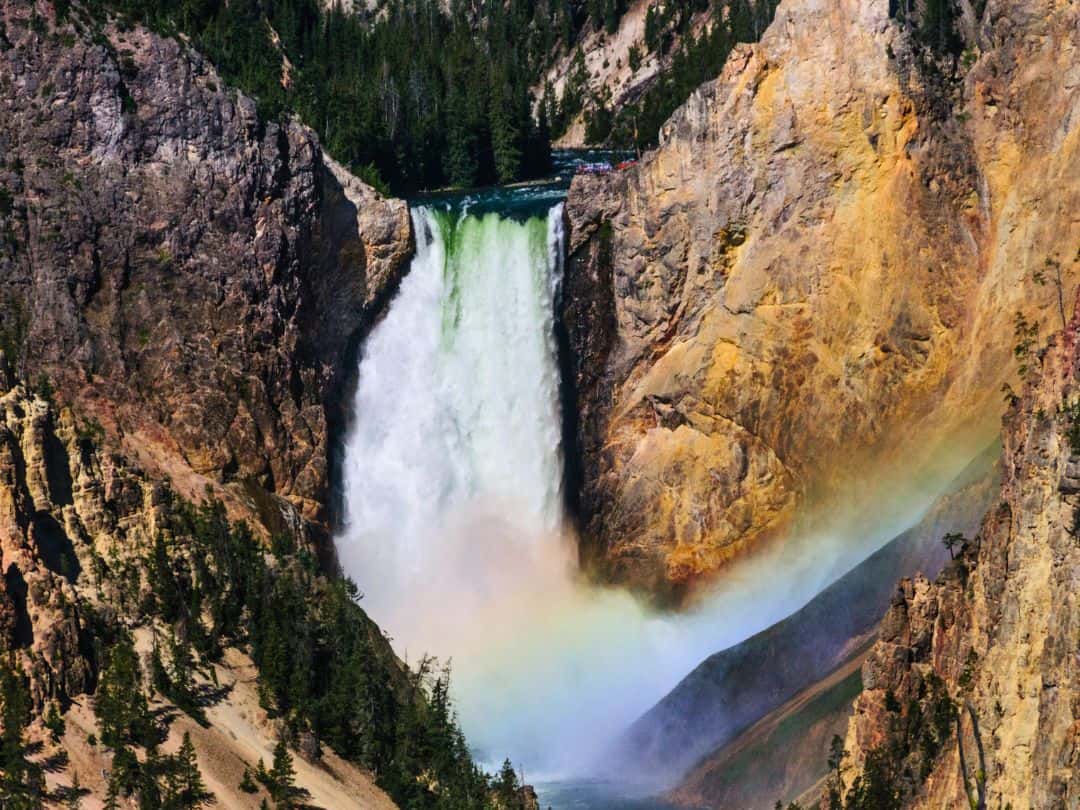
Lower Falls in the Grand Canyon of Yellowstone / Best Photography Locations in Yellowstone
Mammoth Hot Springs Terraces at Sunset
Mammoth Hot Springs is a place of wonder! Its intricate terraces, shaped by the flow of hot water and minerals from the depths of the Earth, are a geological marvel.
As I walk among the white and orange travertine formations, I am always captivated by the ever-changing landscape.
But it’s at sunset that Mammoth Hot Springs truly comes alive. The soft, warm light of the setting sun has a magical way of transforming this already surreal landscape into a scene straight out of a dream.
Mammoth Hot Springs Sunset Photography Tips:
- Arrive in the Late Afternoon: I have found that arriving a bit before sunset is the perfect timing. It allows you to wander through the terraces as the light shifts and find the best angles for your shots.
- Wide-Angle and Mid-Range Lenses: I often switch between my wide-angle lens to capture the sweeping views of the terraces and a mid-range lens for those intimate close-ups of the formations.
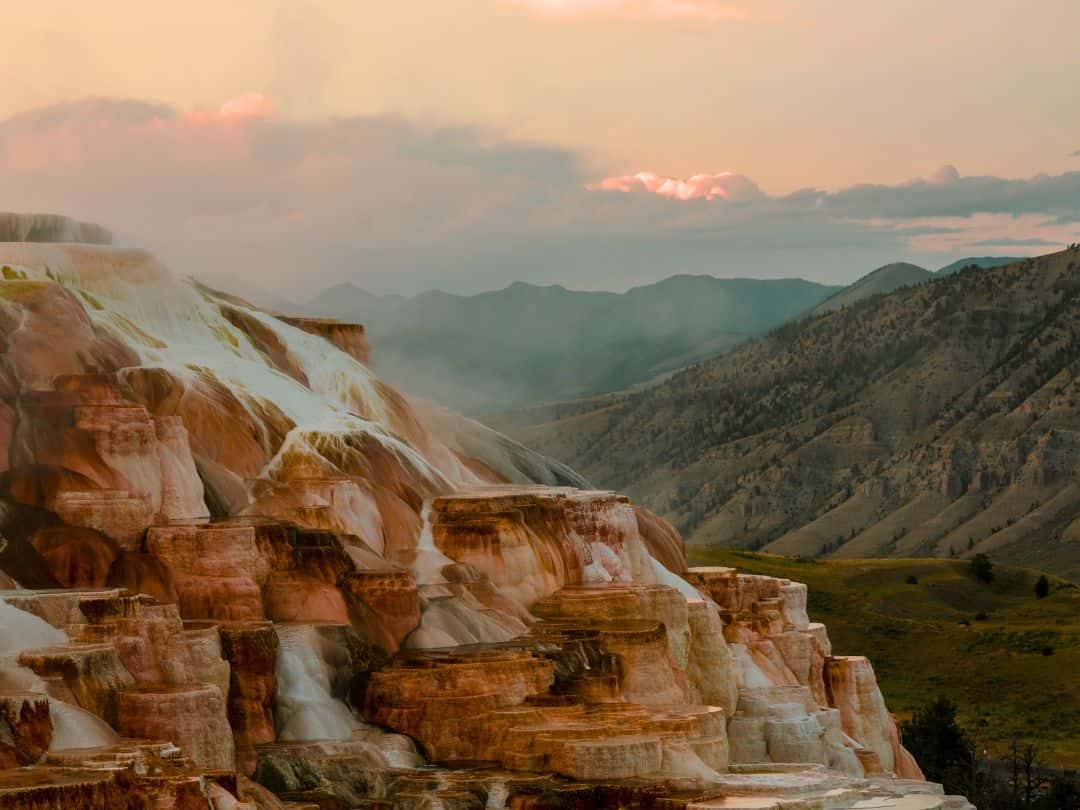
Mammoth Hot Springs / Best Photography Locations in Yellowstone
- Look for Reflections: When water flows over the terraces, it creates these beautiful reflective pools. These pools offer a chance to capture stunning reflections of the terraces and the surrounding landscape.
- Use a Tripod: To ensure your shots are sharp and steady and to experiment with long exposures for that silky water effect, a tripod is an essential companion.
- Silhouette Shots: During sunset, I love to experiment with silhouette shots of the terraces against the colorful sky. It adds a touch of drama and artistry to the images.
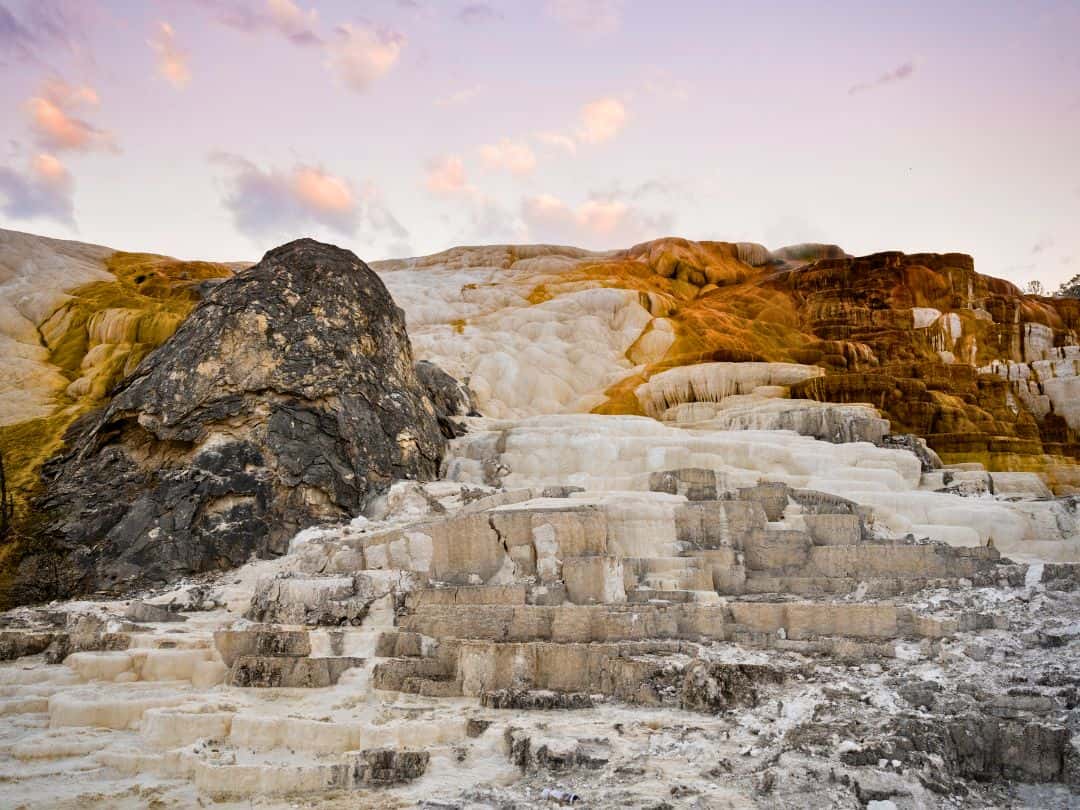
Mammoth Hot Springs / Best Photography Locations in Yellowstone
- Adjust White Balance: Do not hesitate to play with your camera’s white balance settings. Depending on the mood you want to convey, warmer settings can enhance the golden tones of the sunset and make the thermal features pop.
- Capture Details: Last but not least, do not forget to zoom in and capture the intricate textures and patterns of the terraces up close.
These abstract shots can be visually striking and add depth to your collection of Mammoth Hot Springs photographs.
Hayden Valley at Sunrise
Hayden Valley is a vast and picturesque area in Yellowstone, known for its lush meadows, winding Yellowstone River, and, most notably, its diverse wildlife.
It is a prime spot to capture the park’s iconic megafauna, including bison, elk, and grizzly bears, against a stunning natural backdrop.
At sunrise, this location takes on a special charm, with soft, golden light casting a warm glow on the landscape.
Tips for Photographing Hayden Valley at Sunrise:
- Arrive Early: Sunrise is a magical time in Hayden Valley, and arriving well before sunrise allows you to set up and capture the changing light as the sun ascends.
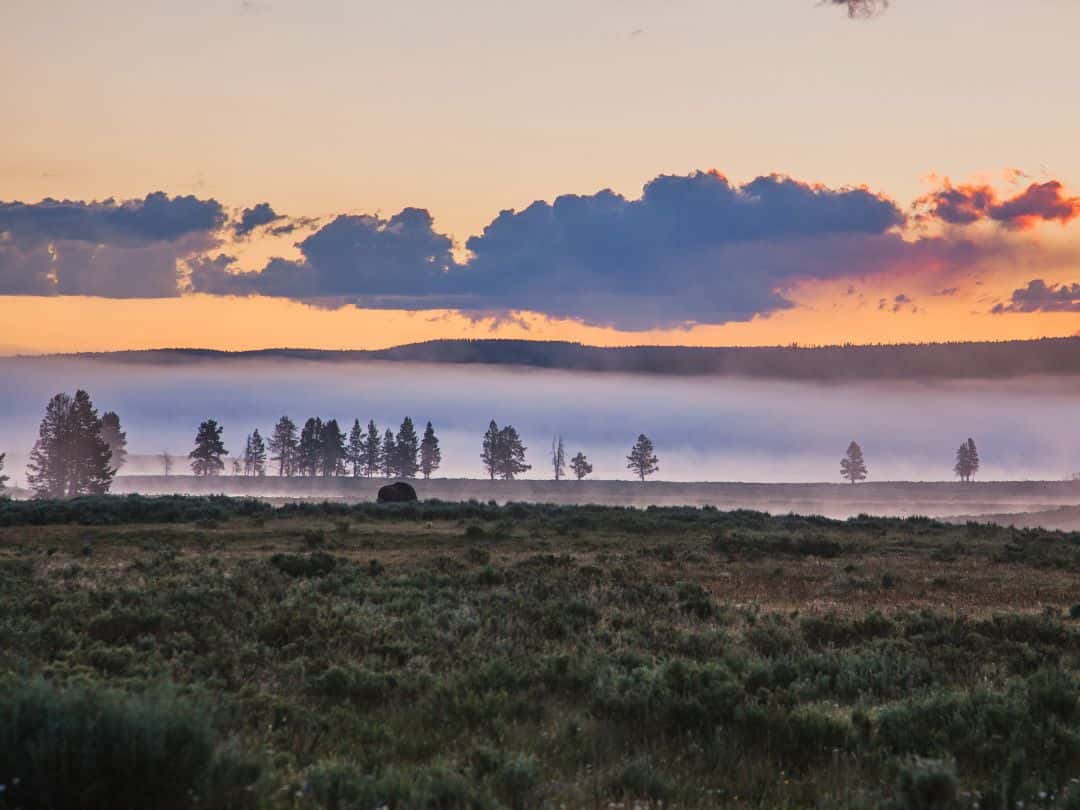
Hayden Valley at Sunrise / Best Photography Locations in Yellowstone
- Use a Telephoto Lens: Wildlife, such as bison and elk, is often active in the morning. A telephoto lens (200-400mm) can help you capture these animals from a safe distance.
- Include the River: The winding Yellowstone River adds depth and interest to your compositions. Use it as a leading line to draw the viewer’s eye into the scene.
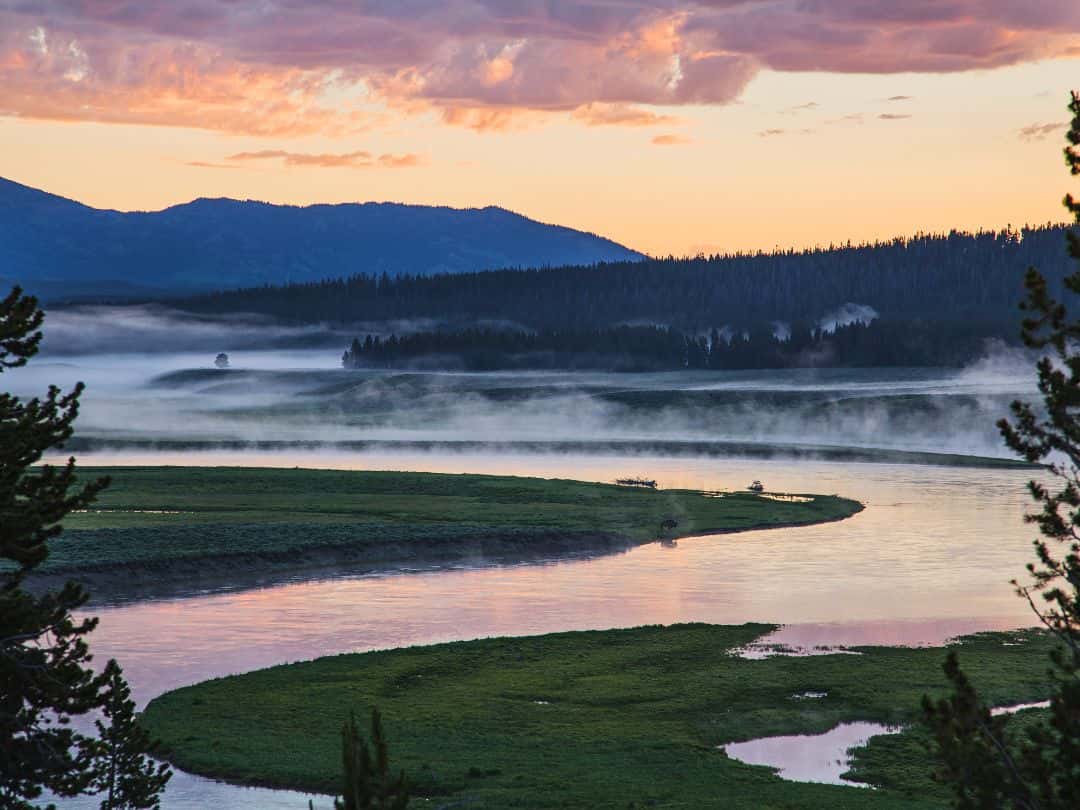
Hayden Valley at Sunrise / Best Photography Locations in Yellowstone
- Compose with Foreground Elements: Include elements like grasses, flowers, or nearby trees in the foreground to add depth and context to your photos.
- Bracket Your Shots: Since sunrise can present challenging lighting conditions, consider bracketing your shots (taking multiple exposures at different exposures) to capture details in both shadows and highlights.
- Patience and Observation: Spend time observing the wildlife and their behavior. This can help you anticipate their movements and capture more compelling moments.
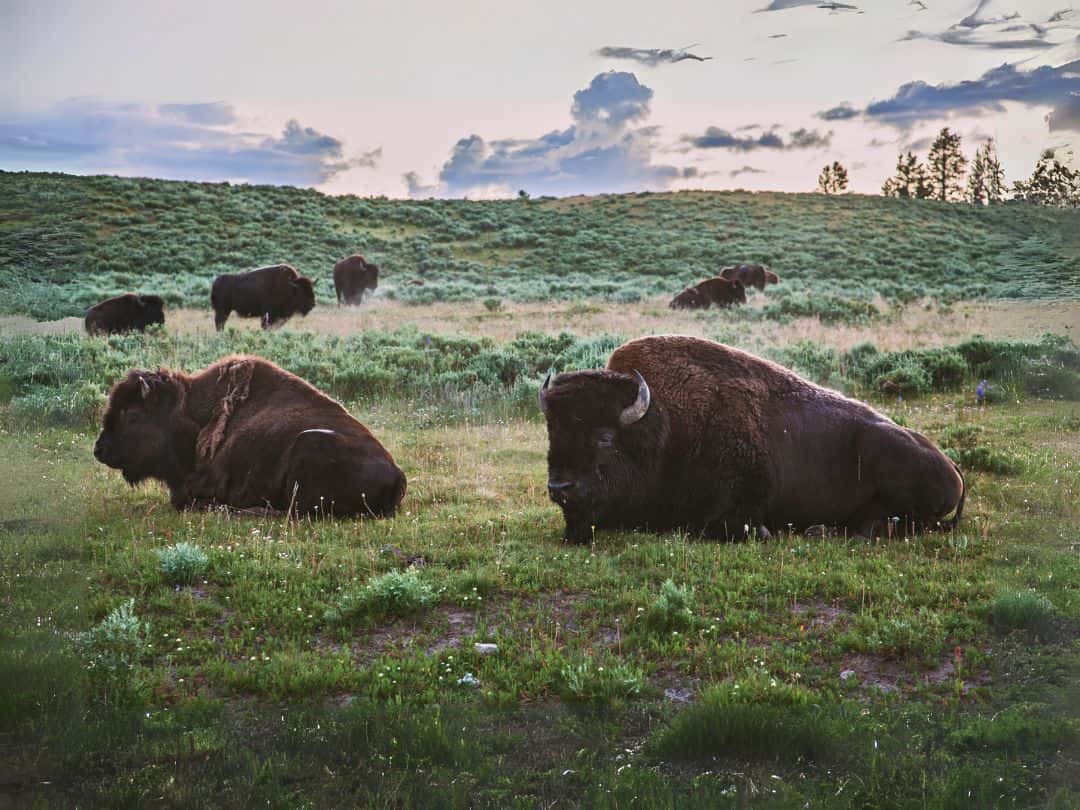
Bison in Hayden Valley at Sunrise / Best Photography Locations in Yellowstone
Yellowstone Lake
Yellowstone Lake is the largest high-elevation lake in North America and a serene and picturesque destination within the park.
Its vast expanse provides numerous opportunities for capturing reflections, wildlife, and beautiful landscapes.
Yellowstone Lake Photo Tips:
- Golden Hours for Reflections: Sunrise and sunset are ideal times to capture the lake’s calm surface, which can mirror the surrounding mountains and the sky. This creates stunning reflections in your photographs.
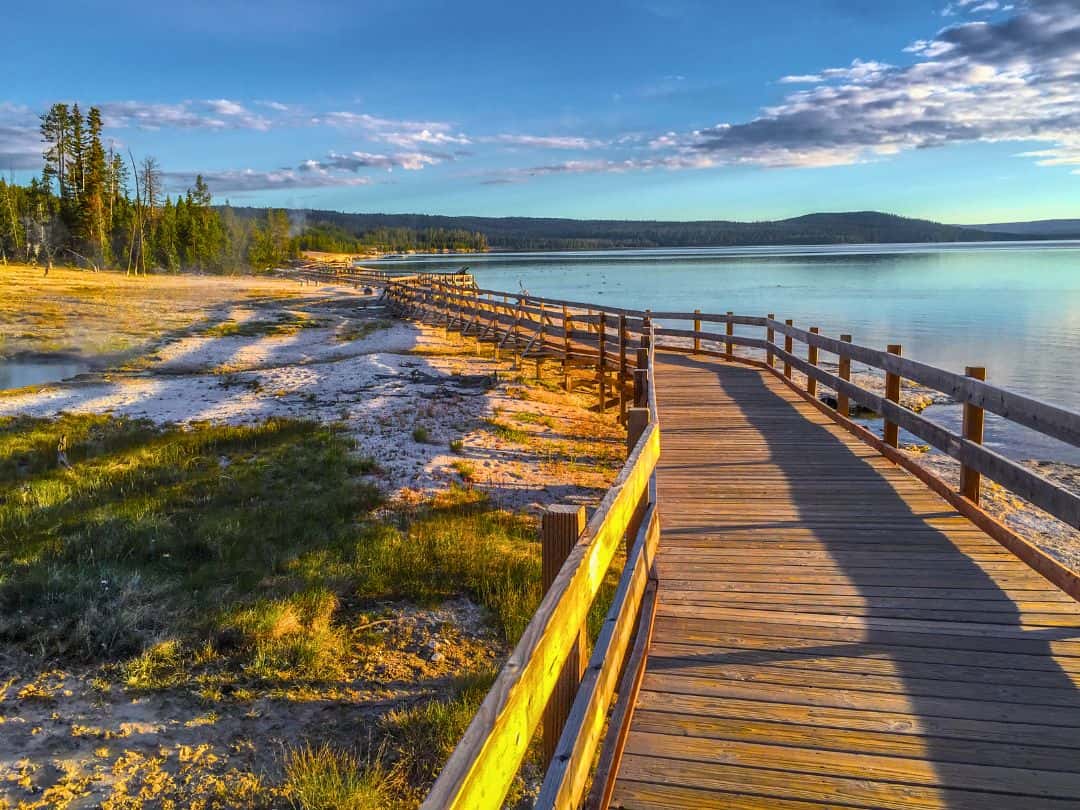
Yellowstone Lake / Best Photography Locations in Yellowstone
- Use a Polarizing Filter: A polarizing filter can reduce glare and enhance the clarity of the water and reflections. It’s particularly useful for midday shots.
- Include Foreground Elements: Add interest to your compositions by including rocks, driftwood, or shoreline features in the foreground. This can create depth and context in your images.
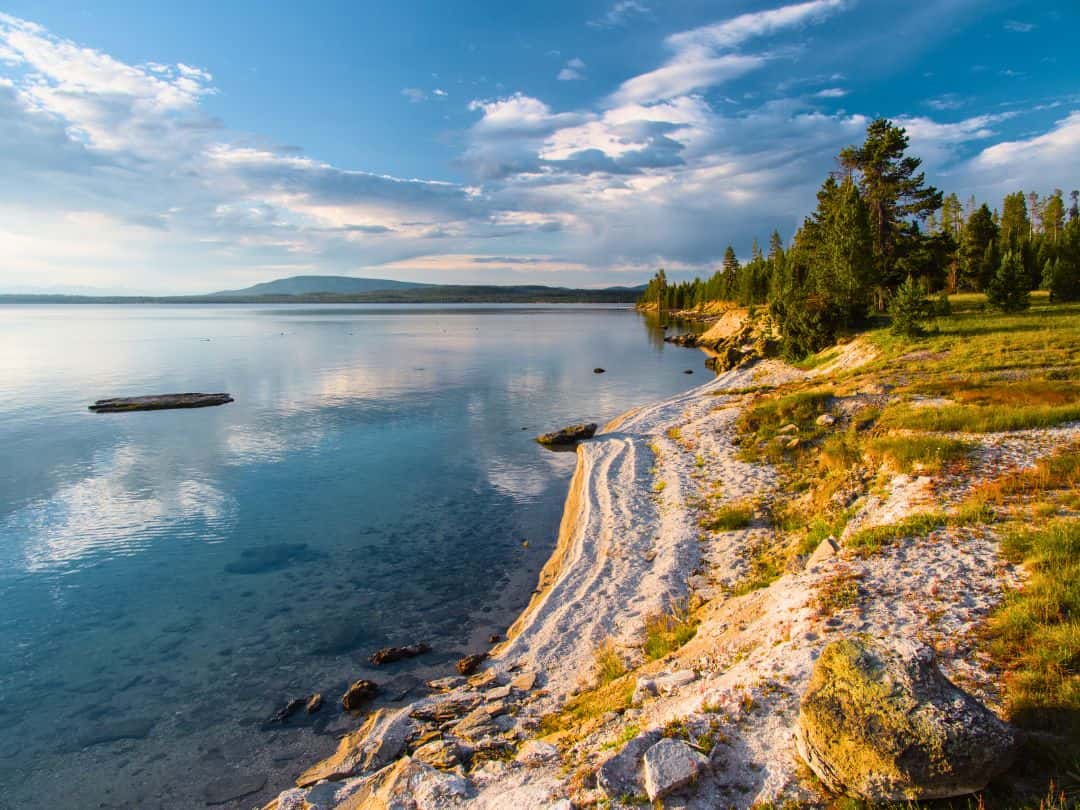
Yellowstone Lake / Best Photography Locations in Yellowstone
- Experiment with Long Exposures:
If you want to smooth out ripples on the lake’s surface or capture cloud movement, consider using a neutral density (ND) filter for longer exposures.
- Kayak Tours for Unique Angles: Consider taking a kayak tour on Yellowstone Lake. This can provide you with unique angles and perspectives not accessible from the shore.
PRO TIP: I enjoyed the Twilight Paddle Tour along the northwestern shores of Yellowstone Lake. Watching the steam rise above the nearest geyser basin as the sun sets, you will understand why Yellowstone deserves the title of the world’s first national park.
Biscuit Basin
Biscuit Basin is a smaller, yet visually captivating, thermal area in Yellowstone. It’s known for its colorful and active hot springs, geysers, and microbial mats. This basin offers a more intimate experience with Yellowstone’s geothermal features.
Biscuit Basin Photography Tips:
- Visit in Good Light: Similar to other thermal areas, the colors in Biscuit Basin are best captured in good lighting conditions. Aim for early morning or late afternoon shots.
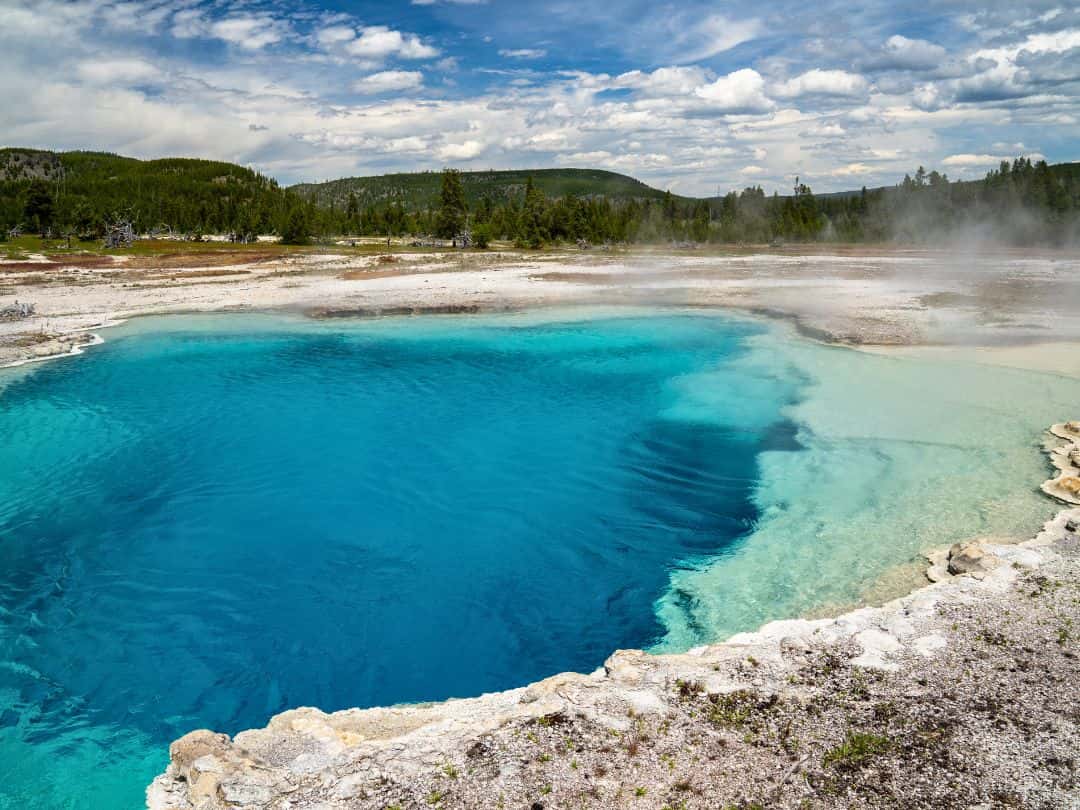
Sapphire Pool in Biscuit Basin / Best Photography Locations in Yellowstone
- Use a Tripod: Steady your camera on a tripod to capture the small details and textures in the thermal features. This also helps with long exposures if desired.
- Highlight Contrasts: Emphasize the contrast between the vibrant colors of the springs and the surrounding terrain. Position yourself to capture these vivid color variations.
- Macro Photography Opportunities: Biscuit Basin is a great place for macro photography. Get up close to the intricate patterns and textures of the microbial mats and mineral deposits.
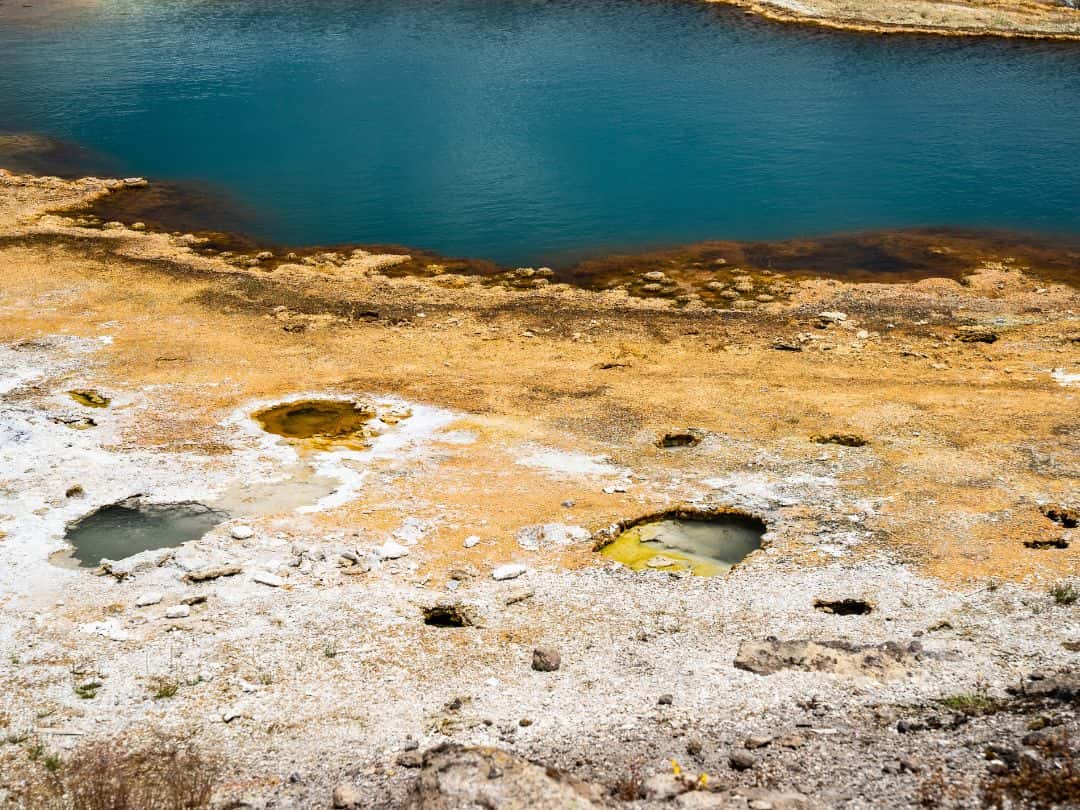
Black Opal Pool in Biscuit Basin / Best Photography Locations in Yellowstone
- Be Cautious of Steam: Steam can obstruct your view and affect your equipment. Be mindful of your camera’s exposure to steam, and consider using lens hoods or protective covers.
- Include Boardwalks: Incorporate the wooden boardwalks that wind through the basin into your compositions. They can lead the viewer’s eye and provide scale to the images.
Firehole Falls
Firehole Falls is a stunning waterfall on the Firehole River, located in the southwestern part of Yellowstone National Park. It’s known for its impressive drop and the way the river dramatically narrows as it plunges into the gorge below.
Pro Tips for Photographing Firefalls:
- Use a Tripod: To capture the flowing water with a silky smooth effect, use a tripod to stabilize your camera and enable longer exposure times.
- Experiment with Shutter Speeds: Play with different shutter speeds to achieve the desired effect. A slow shutter speed (1/2 to a few seconds) will create the classic smooth water effect, while a faster shutter speed can capture more dynamic water movement.
- Wide-Angle Lens: A wide-angle lens can help you capture both the waterfall and the surrounding environment in your frame, providing context and a sense of place.
- Complement with Foreground: Consider incorporating interesting foreground elements, such as rocks or foliage, to enhance the composition of your photos.
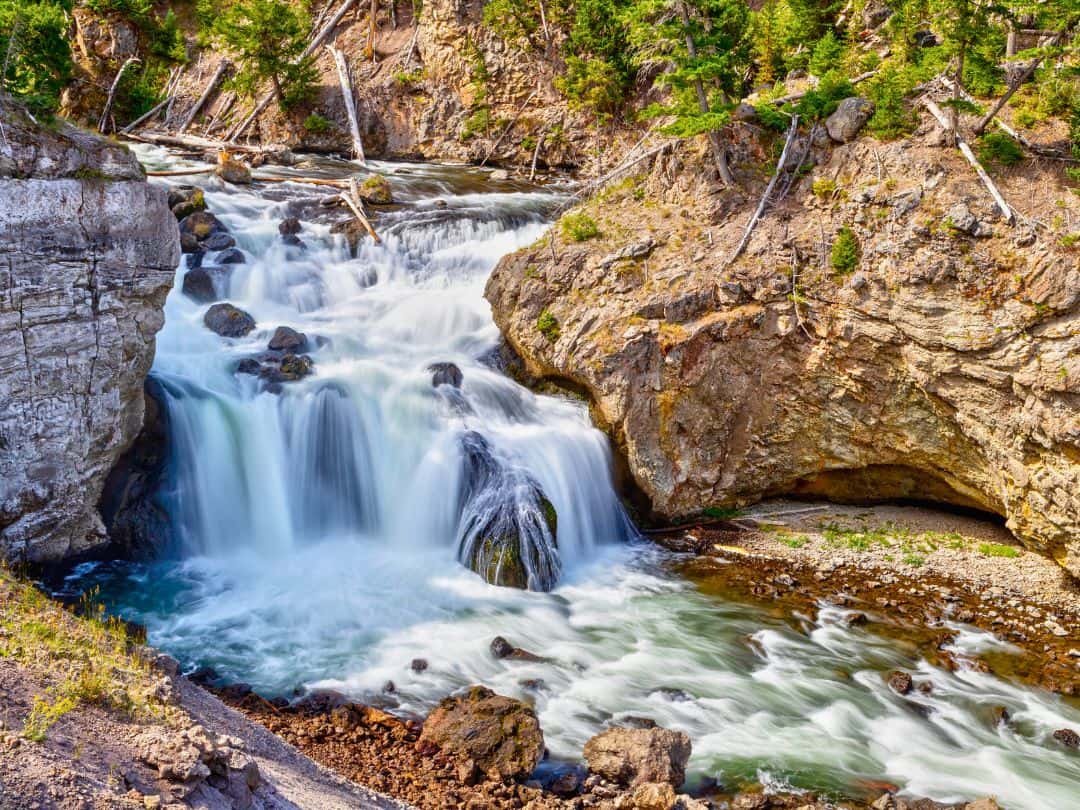
Firehole Falls / Best Photography Locations in Yellowstone
Fairy Falls
Fairy Falls is a place that holds a special charm in my heart. This picturesque waterfall, with its elegant 200-foot drop, stands tall as one of Yellowstone’s tallest. It’s a true gem!
Fairy Falls Photography Tips:
- Use a Tripod: To capture those stunning long-exposure shots that turn the waterfall into a silky masterpiece, I always bring along a sturdy tripod. It is my secret weapon for keeping the camera steady and ensuring I get those crisp, blur-free images.
- Neutral Density (ND) Filters: ND filters are a must for creating those dreamy, time-defying waterfall shots. They allow for longer shutter speeds, which result in that classic and captivating waterfall effect.
- Compose with Foreground Elements: To add depth and context to my compositions, I love including foreground elements like rocks, trees, or the river itself. It’s a simple technique that can elevate your photos.
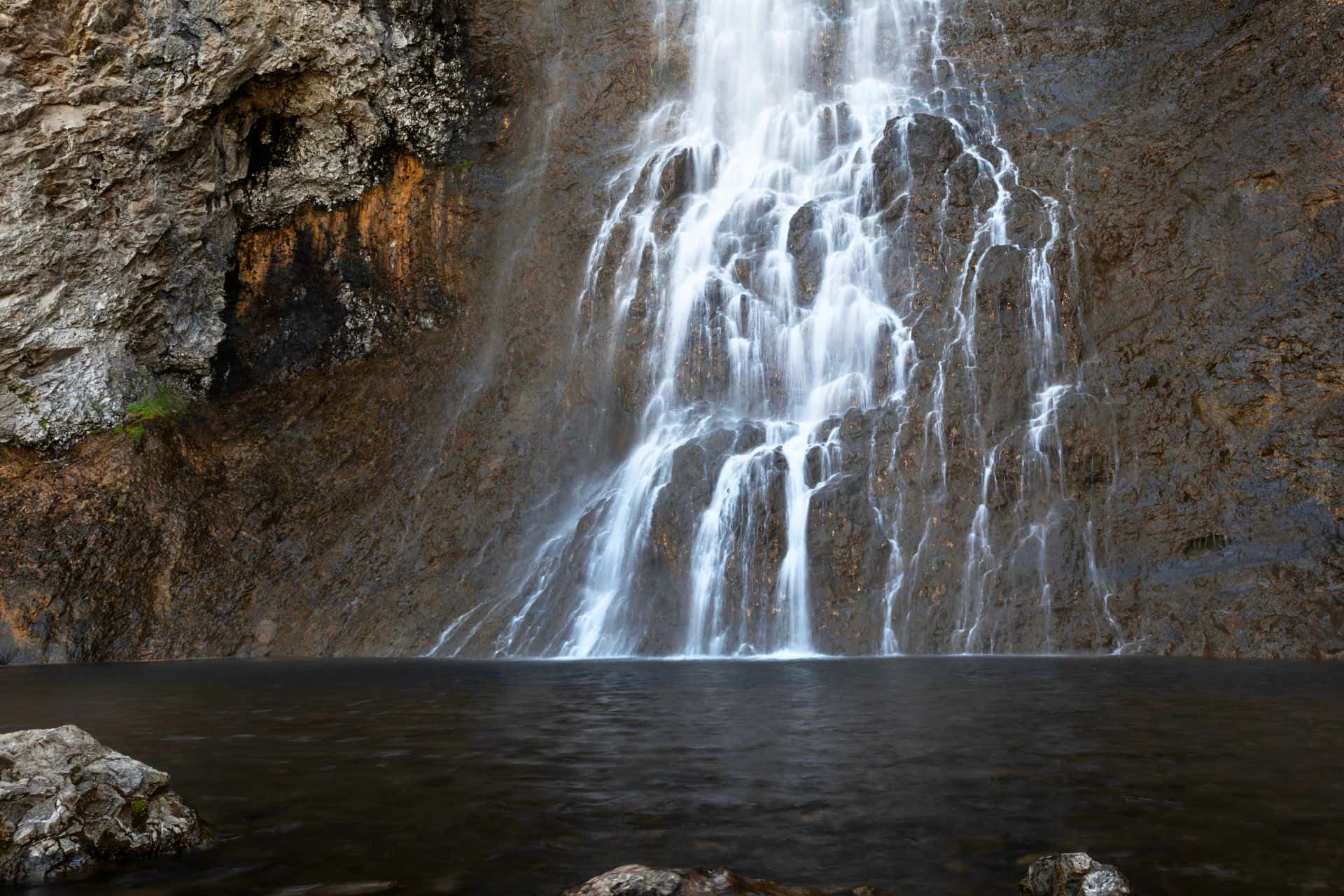
Fairy Falls / Best Photography Locations in Yellowstone
Fountain Paint Pots
Fountain Paint Pots is another fascinating geothermal area located in the Lower Geyser Basin, known for its bubbling mud pots and colorful hot springs.
Fountain Paint Pots Photography Tips:
- Wide-Angle and Mid-Range Lenses: A wide-angle lens is perfect for capturing the overall scene, including the colorful pools and surrounding landscape. A mid-range zoom lens (24-70mm) can be versatile for close-ups.
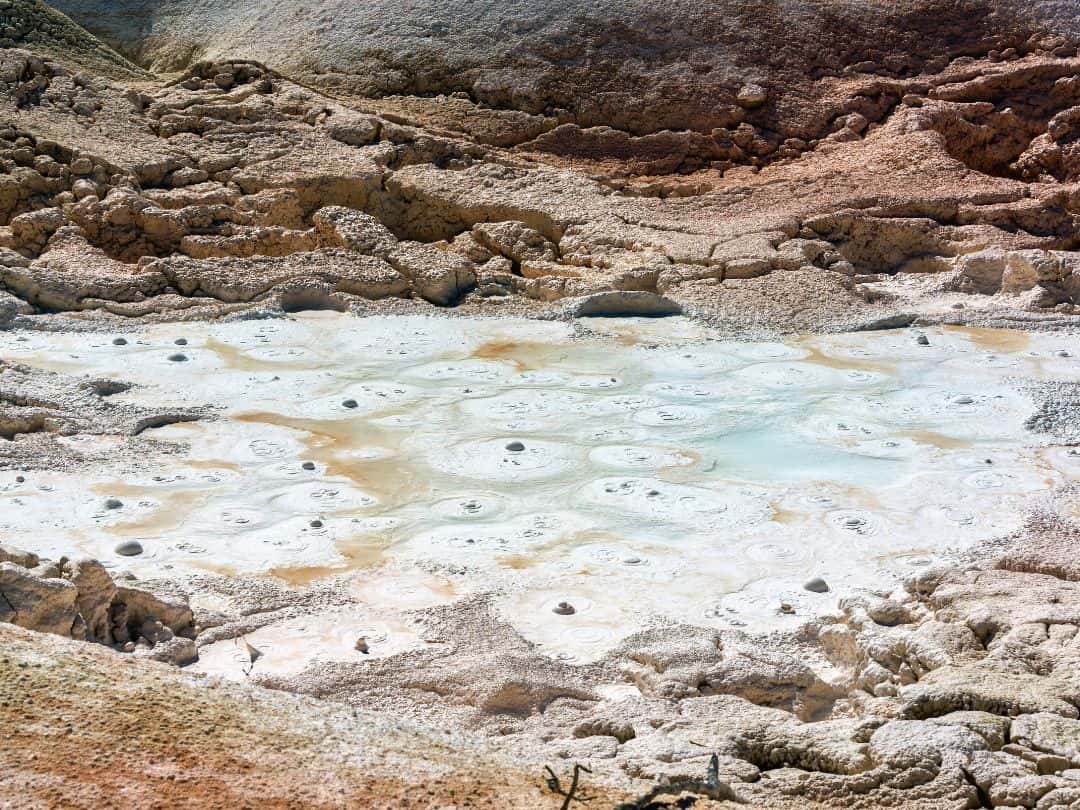
Fountain Paint Pots / Best Photography Locations in Yellowstone
- Experiment with Compositions: Focus on the intricate textures and patterns of the mud pots and the vibrant colors of the hot springs. Get creative with your compositions to emphasize these elements.
- Use a Tripod: Steady your camera on a tripod to capture sharp images and enable longer exposures, especially if you want to capture the movement of bubbling mud.
- Capture Action: Try to capture the dynamic nature of the mud pots as they bubble and gurgle. Fast shutter speeds can freeze the action, while slow shutter speeds can convey a sense of movement.
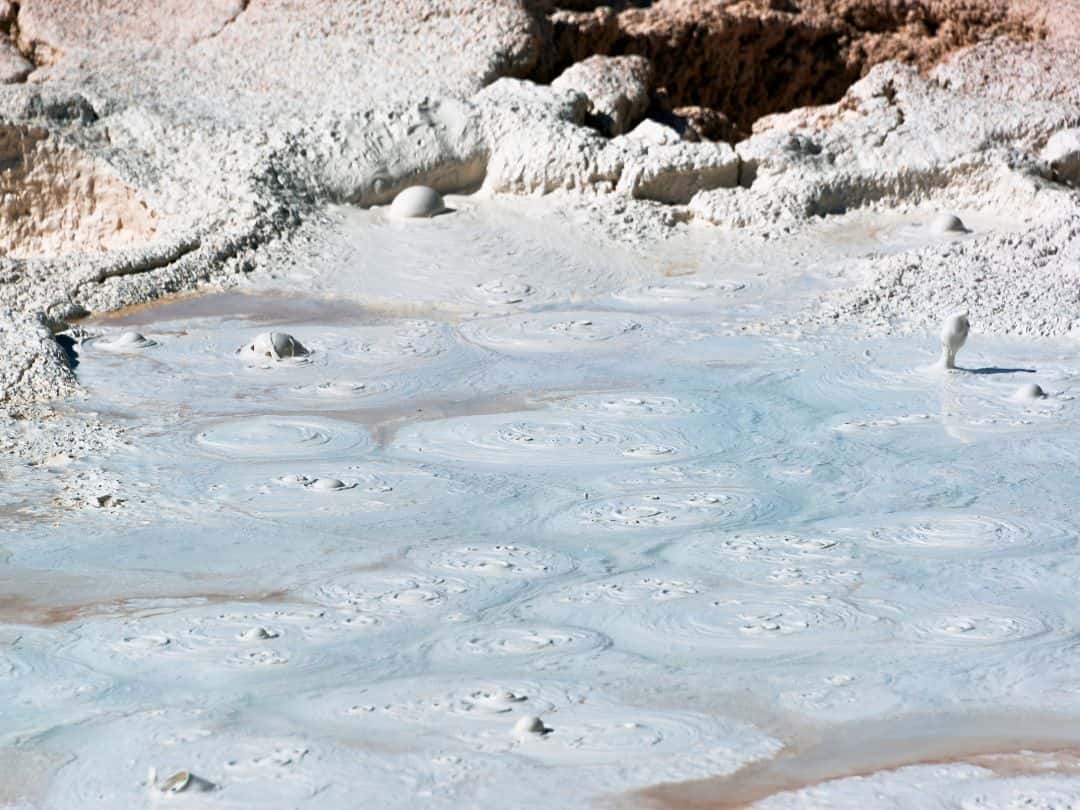
Fountain Paint Pots / Best Photography Locations in Yellowstone
Intrepid Scout's Tips for Best Photography Locations in Yellowstone
Best Photography Locations in Yellowstone:
- Grand Canyon of Yellowstone: For me, the Grand Canyon of Yellowstone is a marvel that never ceases to amaze. From Artist Point to Inspiration Point, Brink of Lower Falls to Brink of Upper Falls, these four locations offer unparalleled vistas of this geological masterpiece.
- Mammoth Hot Springs: Mammoth Hot Springs is where nature’s artistry truly shines. The intricate terraces, adorned with white and orange travertine formations, make it a must-visit. And during sunset, it becomes pure magic.
- Fairy Falls: Fairy Falls stands tall as one of Yellowstone’s tallest waterfalls. Its graceful cascade amidst lush greenery is a sight to behold.
Best Photography Tips:
- Timing is Crucial: The golden hours of sunrise and sunset are your best friends. Soft, warm light during these times enhances colors and textures.
- Use a Tripod: A sturdy tripod is your secret weapon for capturing those silky waterfall shots or intricate thermal features. It ensures steady images, especially during long exposures.
- Compose Thoughtfully: Do not just capture the subject; tell a story. Incorporate foreground elements, reflections, or surrounding landscapes to add depth and context to your compositions.
Best Wildlife Photography in Lamar Valley:
- Lamar Valley: Often called the “Serengeti of North America,” Lamar Valley is a wildlife photographer’s dream. Bison, elk, wolves, and grizzly bears call this place home, offering incredible opportunities for capturing Yellowstone’s fauna.
- Golden Hour Magic: Wildlife is most active during the golden hours of sunrise and sunset. Plan your visit accordingly for soft, warm lighting that enhances your animal portraits.
- Long Lenses are Essential: To capture distant wildlife without disturbing them, invest in a telephoto lens (300mm or more) for close-up shots. Binoculars can help you spot animals from afar.
- Patience and Observation: Spend time observing animal behavior before taking shots. This allows you to anticipate their actions and capture more compelling moments.
Best Geothermal Photography in Biscuit Basin:
- Biscuit Basin: This smaller thermal area offers a more intimate experience with Yellowstone’s geothermal features, like sapphire pools and colorful springs.
- Macro Opportunities: Biscuit Basin is perfect for macro photography. Get up close to capture intricate patterns and textures of microbial mats and mineral deposits.
- Visit in Good Light: Just like other thermal areas, the colors in Biscuit Basin shine in good lighting conditions, so aim for early morning or late afternoon shots.
- Highlight Contrasts: Emphasize the contrast between the vibrant colors of the springs and the surrounding terrain.
You Might Also Like
Guide to the Upper Geyser Basin in Yellowstone (5 Sections, Trails, Best Attractions+Maps)
Perfect One Day in Yellowstone (8 Things You Can’t Miss!)
5 Entrances to Yellowstone (Which One Is the Best Gateway to the Park)
Where to Stay When Visiting Yellowstone (20 Best Lodging Options Inside or Near the Park)
17 Short and Easy Hikes in Yellowstone: Perfect for All Ages (Maps+Useful Tips)
23 Best Stops on Yellowstone Lower Loop Drive (Maps+Useful Tips)
16 Best Stops on Yellowstone Grand Loop Drive (Maps+Useful Tips)
Grand Canyon of the Yellowstone: 3 Scenic Drives, Hikes, Amazing Viewpoints
5 Best Places to See Wildlife in Grand Teton National Park (Maps +Tips)
6 Best Photography Locations in Grand Teton (+Useful Photo Tips)
Did You Find This Useful?
Why Not Best Photography Locations in Yellowstone to Your Pinterest Board!
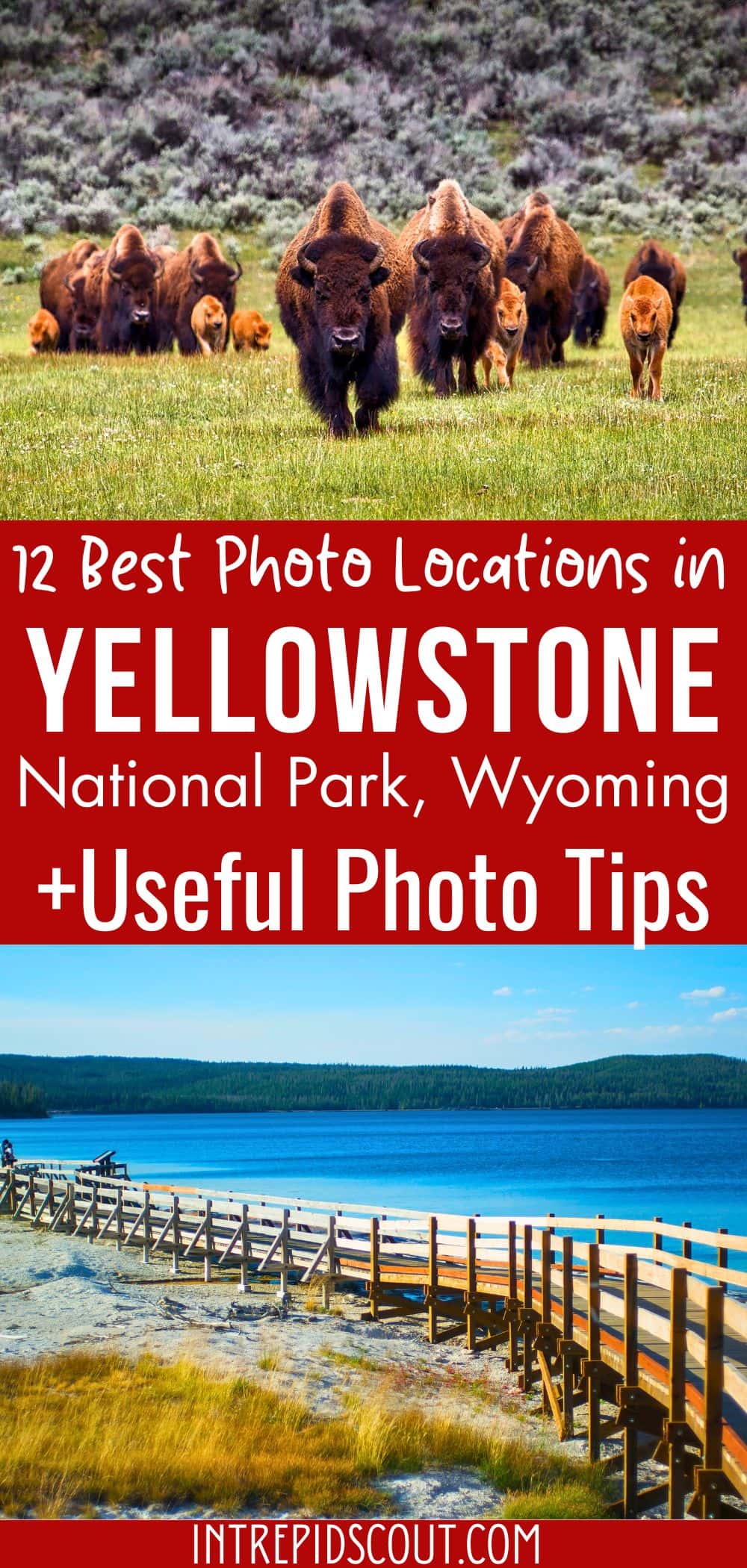
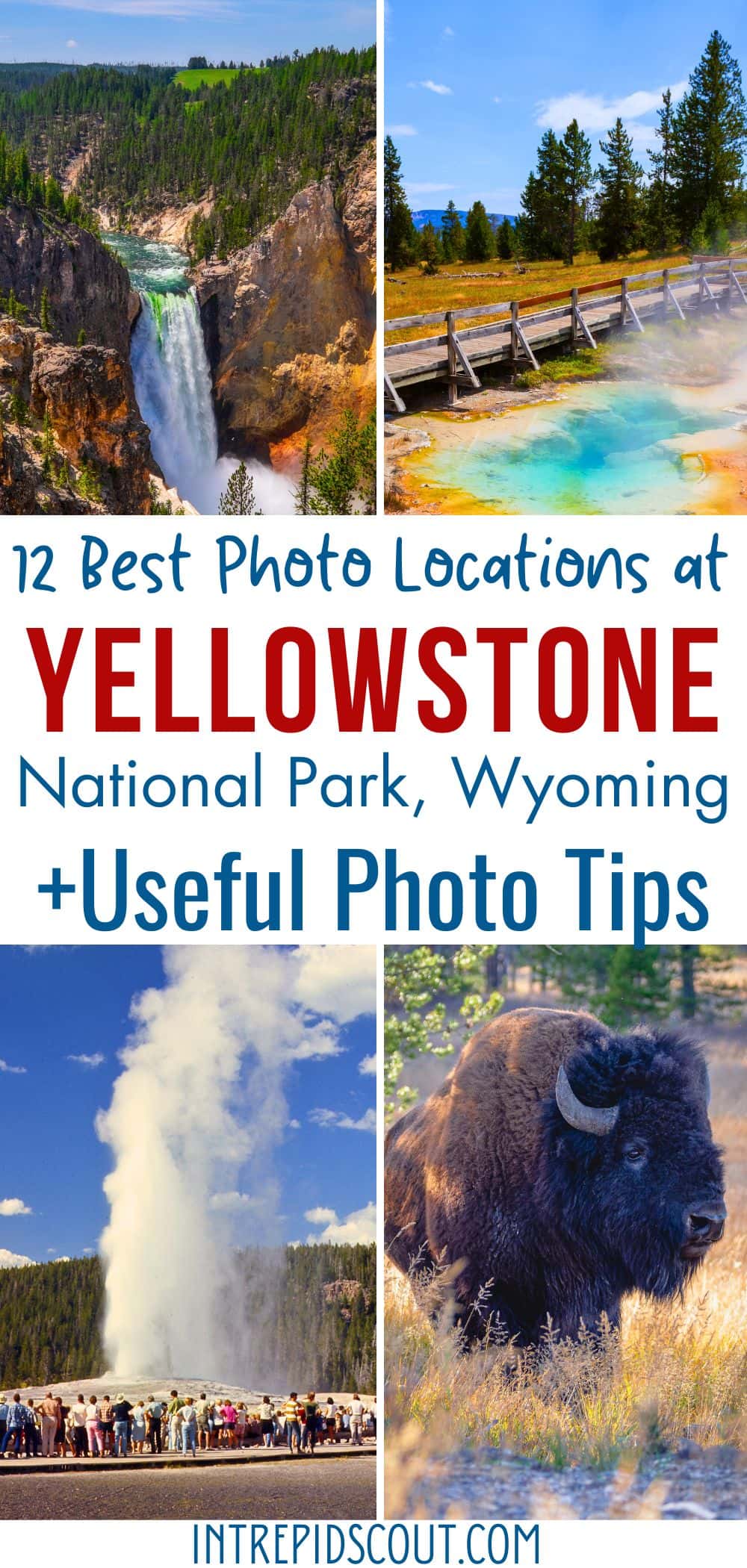
Now, It Is Your Turn, I Would Like to Hear Back from You!
Are you planning your trip to Yellowstone National Park?
Please let me know! Drop me a quick comment right below!
Click on any of the images below to get inspired and to help you with the planning process for your trip to Yellowstone National Park!
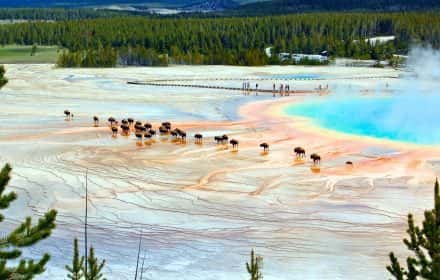
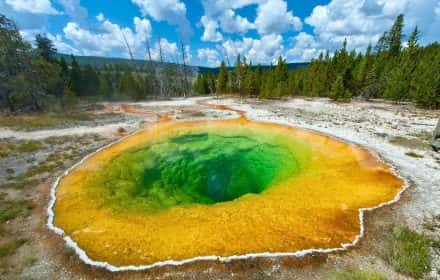
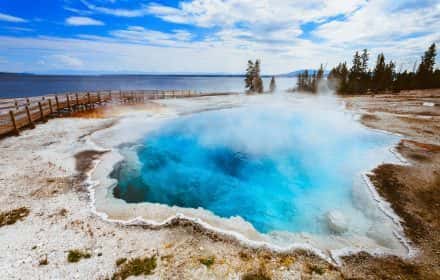
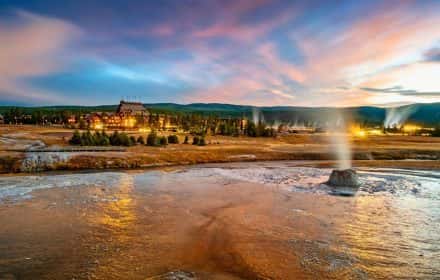
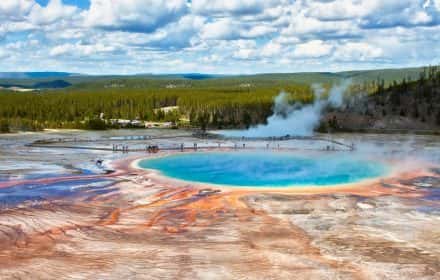
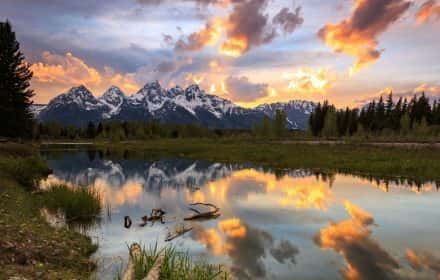
Comments:
2 thoughts on “12 Best Photography Locations in Yellowstone (+Useful Photo Tips)”
Thank you for the information and advice. We (my wife and 4 boys) are planning to visit Yellowstone next year from UK. I’ve saved this page to my Yellowstone collection:)
Hi Tom,
Thank you! You made my day! You will love Yellowstone National Park. If you need more inspiration, I have a bunch of posts about Yellowstone.
Take care,
Anna